Other things I loved about Iran
With Iran's elections coming to a close, I am reminded of all my April tour pictures gathering dust in the folder on my computer's desktop. Here are some more images from the trip:
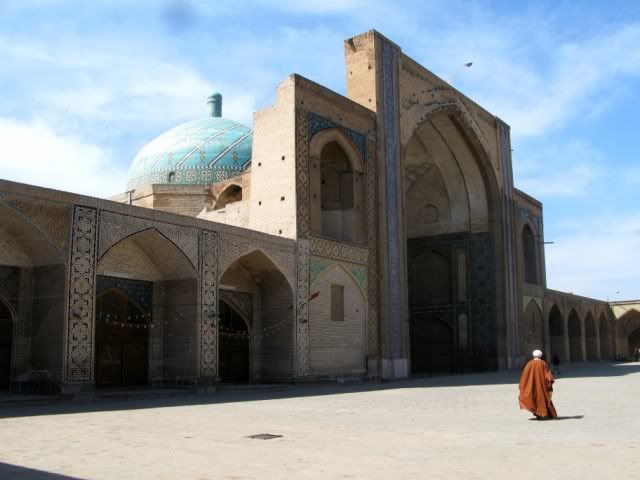
I took this picture at the Jameh Mosque in Qazvin (Kaz-veen), in the most northwesterly part of the Tehran province. The man in the brown robe is a holy man who studied at seminary. I didn't speak with him, but I know that much about him because of the white turban he wears. Only men who have completed religious studies (or who are currently in the seminary) are allowed to wear the white turban. I also know that the man in the brown robe is not a direct descendant of the prophet Muhammad. If he were, he'd be wearing a black turban, just like the ayatollah does.
Now Ahmadinejad has gone on in the past about how there are no gay people in Iran, but Iranian folks know that's not true if for no other reason than the fact that Qazvin, the town where I took this photo, is often made fun of for its reportedly high concentration of homosexuals. The locals love to say, "if you drop your wallet in Qazvin, don't bend down to pick it up." Our driver's assistant went so far as to give us a humorous demonstration of how to kick your wallet back up into your hands should it fall to the ground in Qazvin. Of course, the wallet thing is a joke, but the assertion that there are no homosexuals in a country of 70 million people is no laughing matter. Our Iranian guide told us that a few years ago, she had an assignment to lead a film crew who had come to interview transgendered Tehranis for a documentary. There's quite a thriving underground of all the different "types" that are said not to exist in Iran.
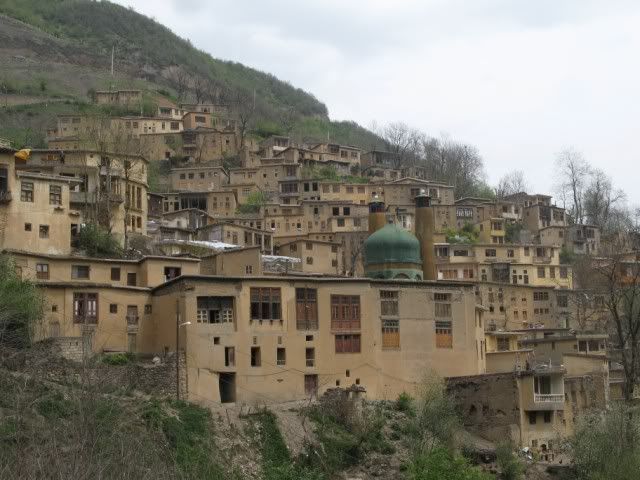
Masouleh is a sweet little village built into a mountainside. We spent an afternoon there for a walk and lunch.
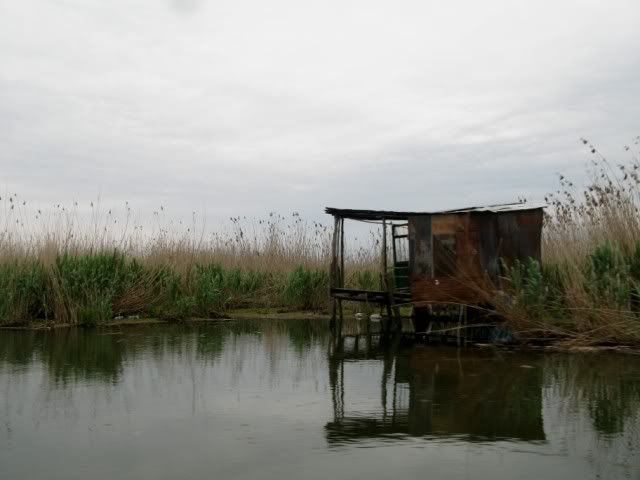
We also took a motorboat ride on a Caspian lagoon. There were 9 of us (7 clients, me, guide) and we piled into two dinghies with outboard motors, each with its own driver, and set off to explore the lagoon. The weather was gorgeous, there were herons all over the place, and abandoned fishing shacks dotted the marshy shores. This one looked especially isolated and mysterious.
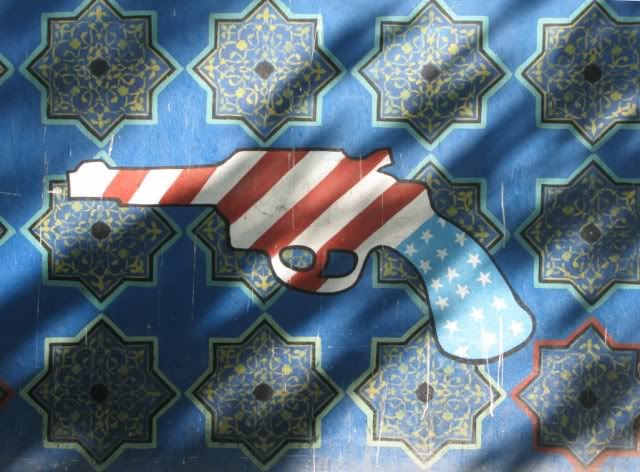
Rick Steves describes Iran as "a paradoxical world where the murals are mean, yet the people are friendly." Back in Tehran, anti-American propaganda is at its strongest right outside the former U.S. Embassy site. The walls of the old embassy have been turned into an open-air museum of revolutionary and anti-U.S. murals. Despite all this, I must reiterate how quick the locals were to inform us that the hatred professed on the murals didn't go any deeper than the paint itself, as far as the ordinary people were concerned.
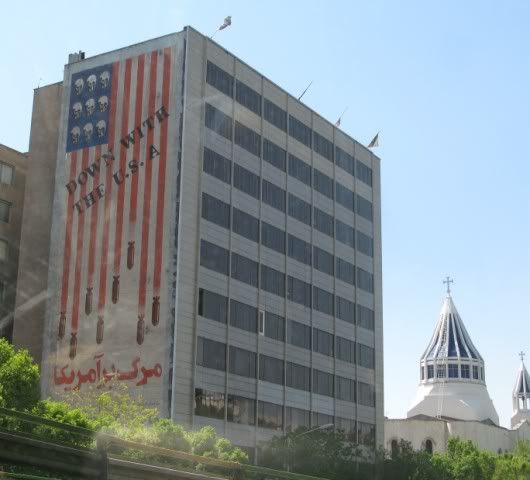
This is the biggest and most famous anti-American mural in all of Iran. That's an Armenian church behind the big building - I found that juxtaposition quite interesting.
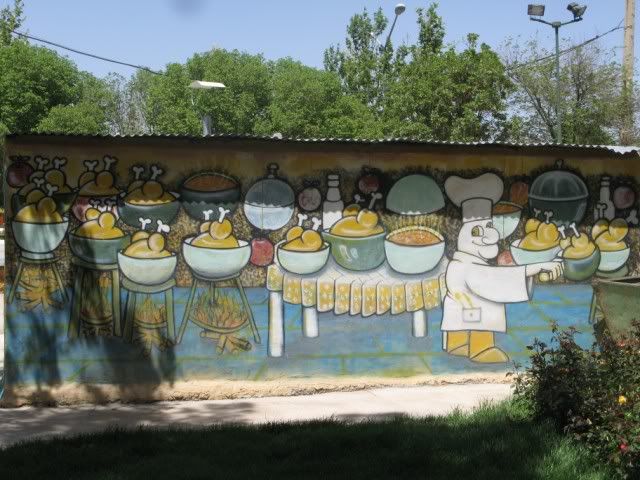
Not all of the murals in Iran are political - some are just plain weird! There should be a caption contest for this image. Any takers?
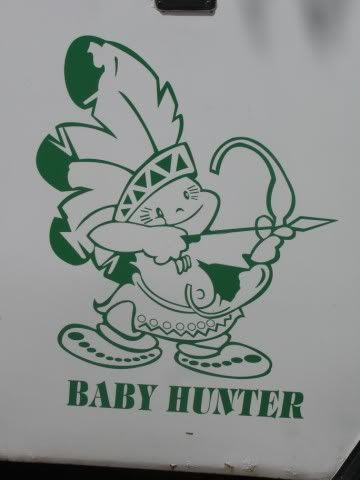
Speaking of just plain weird, the bus decals are OFF THE WALL. This big "Baby Hunter" decal was affixed to the door of a tour bus. Other decals included large cutouts of cowboys and weird phrases like "Gangster Sport" in crazy fonts.

Persepolis was amazing. And eerie. And intimidating. It made me want to learn more about the ancient world (something I really should do).
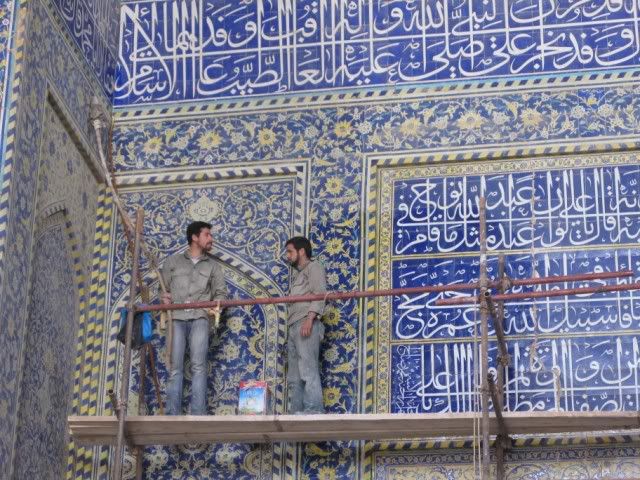
The mosques in Iran are breathtakingly gorgeous, and the people work hard to make sure they stay that way. Most are beautifully and carefully preserved, and cleaned on a regular basis.
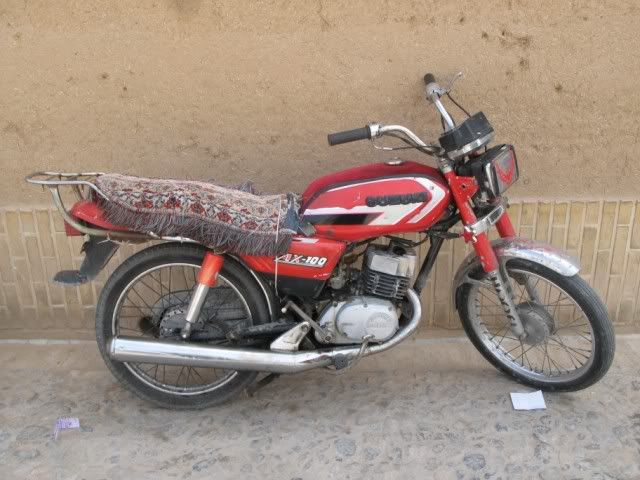
This was just plain cool. Iranians use saddle bags often - on their horses, camels, bicycles and motorcycles...they're everywhere!

The desert town of Yazd was especially beautiful.
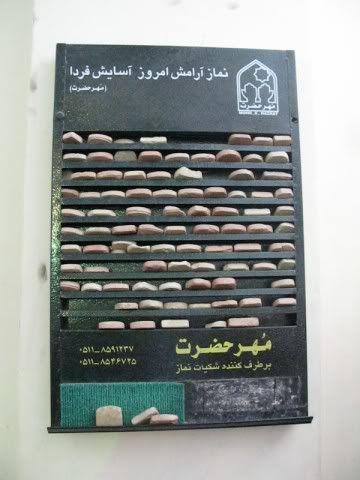
Shi'a Muslims bow their heads to the ground when they pray, but they do not touch their forehead to the earth or their prayer rug. Before beginning their prayers, they place a small engraved stone on their rug where their forehead will touch. When they make the deep bow during prayers and lower their heads to the ground, their foreheads make contact with the stone and keep it from touching the earth. The stones all come from Karbala, Iraq, and a devout Shi'ite is said to have a permanent indentation of the stone on his forehead. Many Shi'a Muslims carry their own "prayer kit" with a mat and stone, but the ones in this picture are for use while in the mosque.
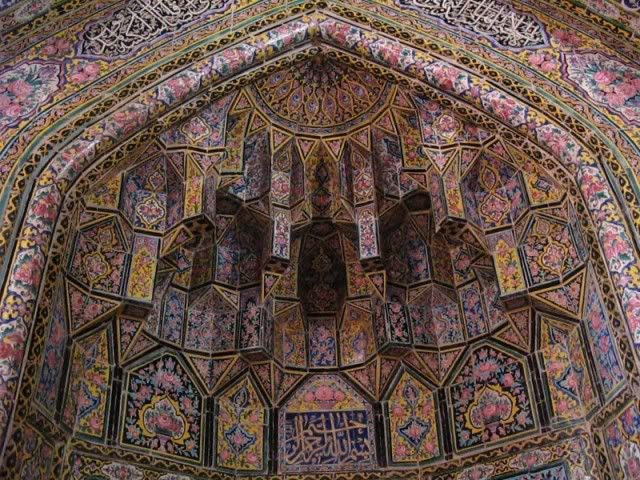
Gorgeous "stalactite" patterns, shown here in an Esfahan mosque, are a common architectural feature.
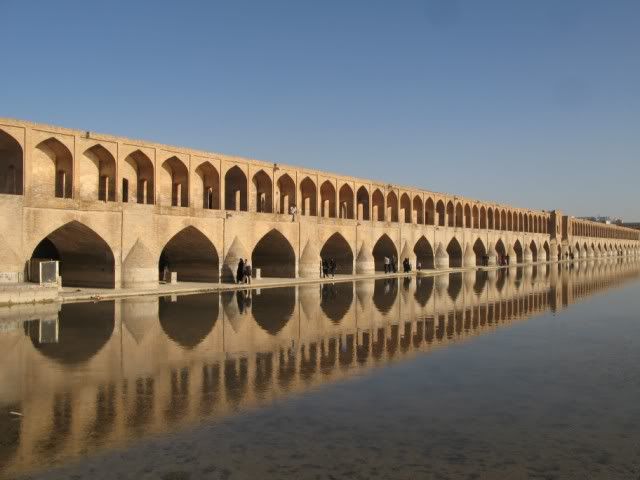
This is Esfahan's 17th century Si-o-se Pol, or "Bridge of 33 Arches." Esfahan has several lovely walking bridges. We crossed Si-o-se Pol on foot one evening and were delighted by the slice of Persian life we viewed among the pedestrians...families, young couples (not touching, but definitely together!) and groups of friends out enjoying themselves and having a stroll. The need to "see and be seen" is as strong here as it is anywhere else.
I'm signing off now so I can go back to reading the Iranian election coverage (okay, and eat Fergus' Friday pizza with my family). We probably won't hear the results tonight, but I'm anxious to see what the news says tomorrow. I hope you all enjoyed this post. Have a good weekend!

I took this picture at the Jameh Mosque in Qazvin (Kaz-veen), in the most northwesterly part of the Tehran province. The man in the brown robe is a holy man who studied at seminary. I didn't speak with him, but I know that much about him because of the white turban he wears. Only men who have completed religious studies (or who are currently in the seminary) are allowed to wear the white turban. I also know that the man in the brown robe is not a direct descendant of the prophet Muhammad. If he were, he'd be wearing a black turban, just like the ayatollah does.
Now Ahmadinejad has gone on in the past about how there are no gay people in Iran, but Iranian folks know that's not true if for no other reason than the fact that Qazvin, the town where I took this photo, is often made fun of for its reportedly high concentration of homosexuals. The locals love to say, "if you drop your wallet in Qazvin, don't bend down to pick it up." Our driver's assistant went so far as to give us a humorous demonstration of how to kick your wallet back up into your hands should it fall to the ground in Qazvin. Of course, the wallet thing is a joke, but the assertion that there are no homosexuals in a country of 70 million people is no laughing matter. Our Iranian guide told us that a few years ago, she had an assignment to lead a film crew who had come to interview transgendered Tehranis for a documentary. There's quite a thriving underground of all the different "types" that are said not to exist in Iran.

Masouleh is a sweet little village built into a mountainside. We spent an afternoon there for a walk and lunch.

We also took a motorboat ride on a Caspian lagoon. There were 9 of us (7 clients, me, guide) and we piled into two dinghies with outboard motors, each with its own driver, and set off to explore the lagoon. The weather was gorgeous, there were herons all over the place, and abandoned fishing shacks dotted the marshy shores. This one looked especially isolated and mysterious.

Rick Steves describes Iran as "a paradoxical world where the murals are mean, yet the people are friendly." Back in Tehran, anti-American propaganda is at its strongest right outside the former U.S. Embassy site. The walls of the old embassy have been turned into an open-air museum of revolutionary and anti-U.S. murals. Despite all this, I must reiterate how quick the locals were to inform us that the hatred professed on the murals didn't go any deeper than the paint itself, as far as the ordinary people were concerned.

This is the biggest and most famous anti-American mural in all of Iran. That's an Armenian church behind the big building - I found that juxtaposition quite interesting.

Not all of the murals in Iran are political - some are just plain weird! There should be a caption contest for this image. Any takers?

Speaking of just plain weird, the bus decals are OFF THE WALL. This big "Baby Hunter" decal was affixed to the door of a tour bus. Other decals included large cutouts of cowboys and weird phrases like "Gangster Sport" in crazy fonts.

Persepolis was amazing. And eerie. And intimidating. It made me want to learn more about the ancient world (something I really should do).

The mosques in Iran are breathtakingly gorgeous, and the people work hard to make sure they stay that way. Most are beautifully and carefully preserved, and cleaned on a regular basis.

This was just plain cool. Iranians use saddle bags often - on their horses, camels, bicycles and motorcycles...they're everywhere!

The desert town of Yazd was especially beautiful.

Shi'a Muslims bow their heads to the ground when they pray, but they do not touch their forehead to the earth or their prayer rug. Before beginning their prayers, they place a small engraved stone on their rug where their forehead will touch. When they make the deep bow during prayers and lower their heads to the ground, their foreheads make contact with the stone and keep it from touching the earth. The stones all come from Karbala, Iraq, and a devout Shi'ite is said to have a permanent indentation of the stone on his forehead. Many Shi'a Muslims carry their own "prayer kit" with a mat and stone, but the ones in this picture are for use while in the mosque.

Gorgeous "stalactite" patterns, shown here in an Esfahan mosque, are a common architectural feature.

This is Esfahan's 17th century Si-o-se Pol, or "Bridge of 33 Arches." Esfahan has several lovely walking bridges. We crossed Si-o-se Pol on foot one evening and were delighted by the slice of Persian life we viewed among the pedestrians...families, young couples (not touching, but definitely together!) and groups of friends out enjoying themselves and having a stroll. The need to "see and be seen" is as strong here as it is anywhere else.
I'm signing off now so I can go back to reading the Iranian election coverage (okay, and eat Fergus' Friday pizza with my family). We probably won't hear the results tonight, but I'm anxious to see what the news says tomorrow. I hope you all enjoyed this post. Have a good weekend!